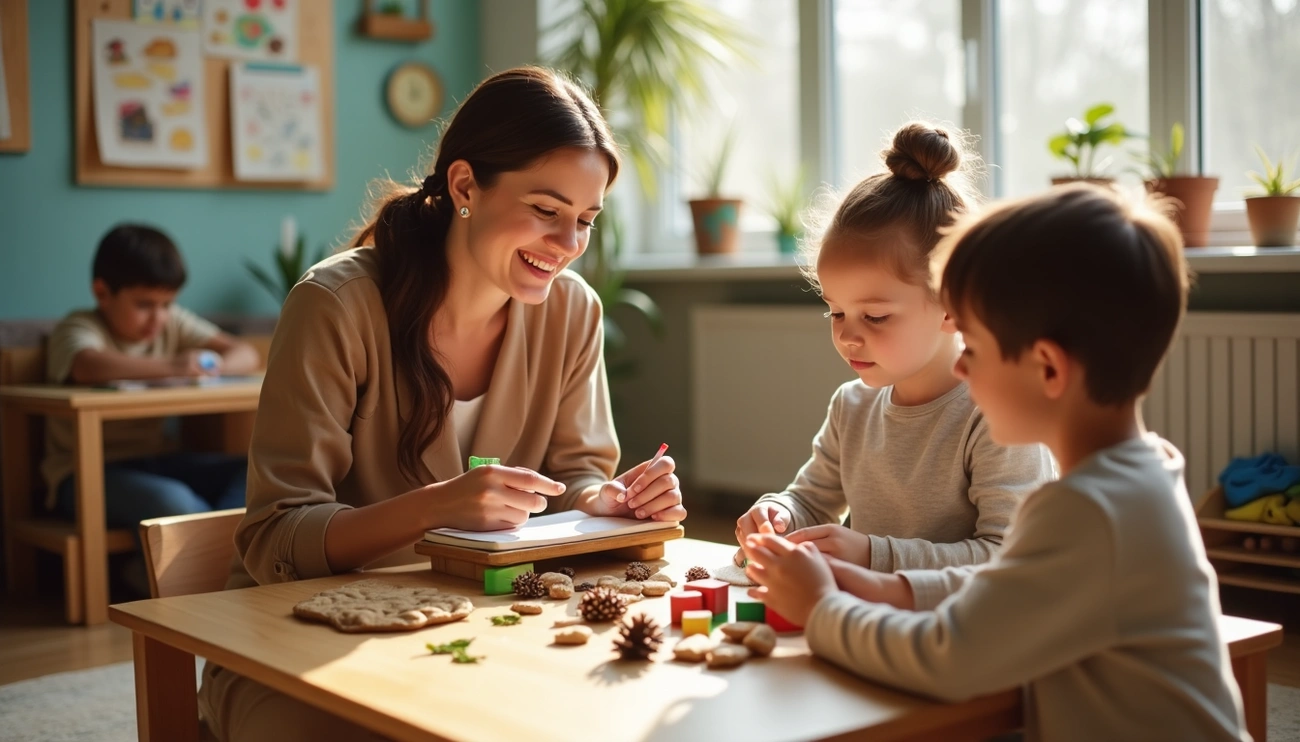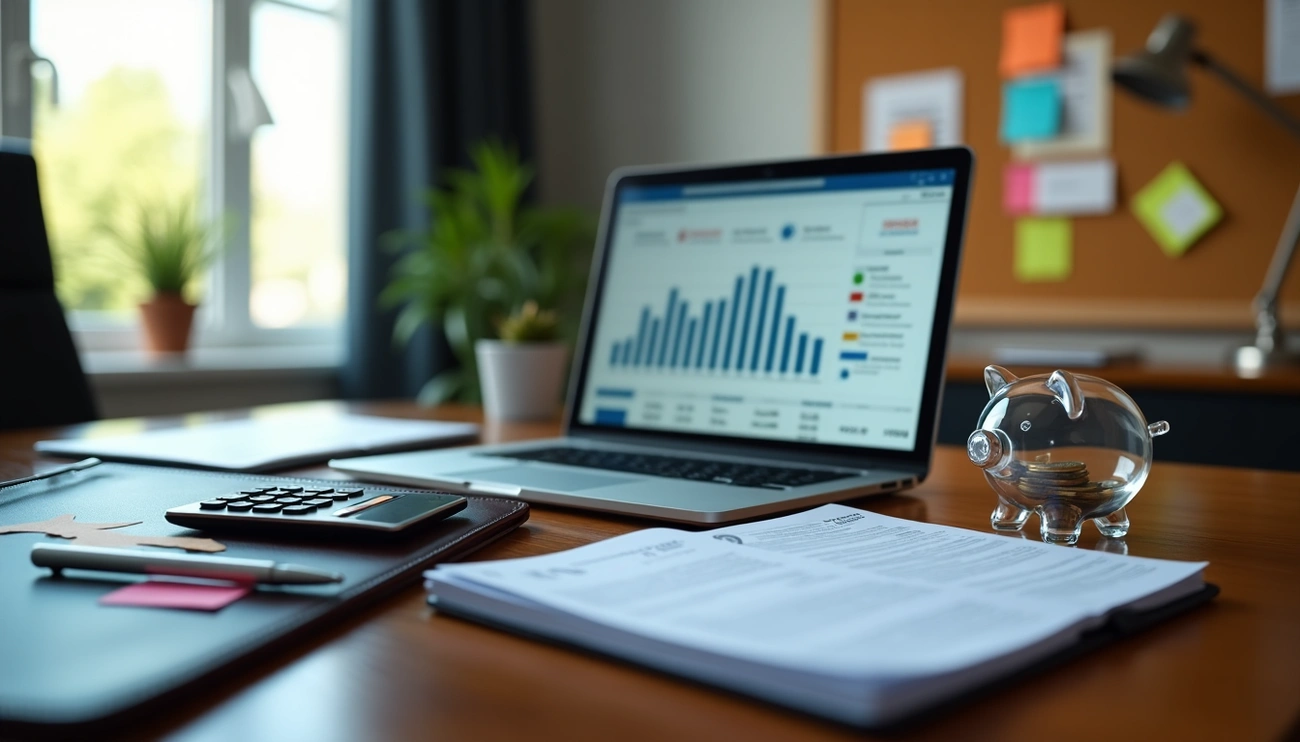Did you know that effective early childhood education can significantly shape a child’s future success?
As teachers, we often find ourselves wondering how to create the perfect balance between structure and flexibility in our classrooms. Planning in early childhood education isn’t just about filling time — it’s about laying the foundation for lifelong learning.
According to the National Association for the Education of Young Children (NAEYC), developmentally appropriate practice requires meeting children where they are while helping them reach goals that are both challenging and achievable. This is exactly why curriculum planning in early childhood education matters so much.
A well-designed early childhood curriculum incorporates foundational literacy and math concepts while also fostering emotional and social growth through music and play. However, creating effective lesson plans for early childhood education can feel overwhelming when you’re juggling multiple responsibilities.
That’s why I’ve created this step-by-step guide. Whether you’re new to teaching or looking to refine your approach, I’ll break down the five key components of the curriculum planning cycle: Observe, Assess, Plan, Implement, and Evaluate. No complicated jargon, no overwhelming theory — just practical advice that you can actually use in your classroom tomorrow.
Ready to become more confident in your planning? Let’s get started!
Step 1: Understand the Purpose of Planning in Early Childhood Education
“The goal of early childhood education should be to activate the child’s own natural desire to learn.” — Maria Montessori, Physician and founder of the Montessori method of education
Planning forms the cornerstone of effective early childhood education, providing the essential framework through which meaningful learning experiences come to life. As early childhood educators, our approach to planning directly influences the quality of education we provide to young children.
What is planning in early childhood education?
Planning in early childhood education is fundamentally about creating a roadmap that guides children’s learning experiences. It involves organizing materials, spaces, resources, and time to maximize opportunities for development and learning.
Essentially, planning is thinking—and this thinking creates intentional teaching. When we plan in early childhood education, we’re making conscious decisions about what children should learn, why they should learn it, and how we’ll facilitate that learning process.
Planning encompasses both formal methods (written lesson plans) and informal approaches that allow for flexibility when unexpected learning opportunities arise. In practice, it means establishing a comprehensive framework that:
- Organizes our work and makes it visible to colleagues, families, and other professionals
- Ensures we maintain appropriate challenges while enabling children to experience success
- Provides structure for introducing new ideas and experiences
- Supports individual children’s interests and strengths
Furthermore, planning isn’t just about filling time—it’s about creating purposeful experiences that promote development across all domains: physical, social, emotional, linguistic, and cognitive.
Why planning matters for child development
The connection between thoughtful planning and child development is profound. Planning helps ensure all children have access to the same development opportunities through a balanced curriculum.
When we plan effectively, we create environments where children thrive because we’ve considered their developmental stages and needs. A well-structured plan provides children with a sense of stability, which is essential for their emotional well-being.
Planning matters primarily because it:
- Establishes routine and structure, which are key for children’s development
- Allows practitioners to identify areas where children need additional support
- Creates opportunities for targeted focus on specific developmental areas
- Promotes balanced learning across all domains
Notably, planning helps us maximize language development by recognizing differences in developmental progressions for monolingual, bilingual, and multilingual children. Through thoughtful planning, we can support each child’s unique developmental journey.
How planning supports curriculum goals
Curriculum consists of plans for learning experiences through which children acquire knowledge, skills, and understanding. Effective planning ensures that these experiences align with broader curriculum goals and early learning standards.
Planning supports curriculum goals by helping us maintain focus on what children are expected to know, understand, and be able to do when they leave our setting. This includes considerations across all developmental domains and subject areas.
In addition, planning helps us thread experiences coherently, creating logical sequences that allow for depth rather than superficially covering many topics. Consequently, children can spend sustained time with select content areas and revisit concepts to facilitate deeper understanding.
Importantly, planning creates a connection between observations and intentional teaching. By planning based on what we observe about children’s knowledge, interests, and learning needs, we can shape and adapt experiences to be responsive to each child while still meeting curriculum objectives.
Through this deliberate planning process, we ensure that the curriculum remains culturally and linguistically relevant—a factor that’s essential for supporting development and learning across all domains.
Step 2: Observe and Document Children’s Learning
The most powerful planning begins with careful observation of children in their learning environment. Observation isn’t merely watching—it’s an intentional process of gathering, recording, and reflecting on information about children’s progress that forms the foundation of the entire planning cycle.
Using observation as a foundation
Observation serves as the heart of early childhood assessment, guiding how I support each child’s unique development journey. Through intentional observation, I create daily habits of watching and recording children’s actions, explorations, and conversations during both independent play and interactions with others. This practice allows me to understand not just what children know, but also how they organize knowledge and experiences, ultimately improving my teaching and their learning.
Effective observation requires being fully present, attentive, and focused. Indeed, I must exercise sensitive observation by watching closely and recording accurately, then revisiting these records to understand what they reveal about children’s daily lives and learning processes.
Moreover, observation helps me:
- Identify each child’s unique attributes, strengths, and interests
- Discover patterns in behavior and development
- Create personalized learning experiences
- Make informed decisions about curriculum planning
Quality observations communicate each child’s individuality and context, providing a comprehensive view of who they are, what they know, and what they can do.
Tools for effective documentation
Documentation transforms observations into tangible evidence that makes children’s learning visible. Primarily, documentation serves as “a systematic act of collecting, interpreting and reflecting on concrete traces of learning”.
I can use several documentation methods depending on what information I need:
Running Records capture detailed, objective accounts of behavior without interpretation. They provide rich, sequential details about a child’s actions written in present tense.
Anecdotal Records offer brief narratives of significant events that spotlight a child’s strengths and progress. These records typically focus on what is significant and are recorded in sequential order.
Frequency Counts gather information about specific behaviors or interests through tally marks within a set timeframe.
Learning Stories communicate more than facts—they highlight key moments in a child’s day through narrative storytelling format.
Additionally, I can use photographs, videos, audio recordings, checklists, time sampling, and work samples to gather comprehensive evidence of children’s development across all domains.
Capturing learning through portfolios
Portfolios provide a structured collection of documentation that tells each child’s unique learning story over time. A well-organized portfolio contains observations and artifacts collected at different periods throughout the school year, highlighting development across all domains.
When creating portfolios, I include:
- Anecdotal notes capturing significant moments
- Photographs of children engaged in various activities
- Art samples and other work samples
- Transcripts of children’s conversations
- Self-portraits showing development over time
Importantly, portfolios aren’t merely cute keepsakes or scrapbooks—they’re powerful tools for demonstrating learning. For instance, I can use portfolios during parent conferences to show actual progress through student work samples rather than simply stating that progress has occurred.
Portfolios also benefit children directly. By revisiting documentation of their experiences and work, children “become even more curious, interested, and confident as they contemplate the meaning of what they have achieved”. This reflection process enhances their learning by allowing deeper thinking, questioning, and dialog about previous experiences.
Ultimately, effective observation and documentation ensure my teaching practices are responsive, intentional, and tailored to each child’s unique needs within the overall curriculum planning framework.
Step 3: Analyze and Set Learning Objectives
After gathering rich documentation of children’s learning, the next critical step is analyzing this information to set meaningful objectives. This analysis phase bridges observation and action, allowing me to create goals that genuinely support each child’s development.
Interpreting observations to identify needs
Interpretation transforms documented observations into insights about children’s development. Throughout this process, I review collected data to identify patterns, strengths, and areas for growth in each child. Specifically, I look for what children can do independently versus what they might achieve with appropriate scaffolding—their zone of proximal development.
When analyzing documentation, I ask myself:
- What growth do I see in this child?
- Where might this child benefit from additional support?
- What interests could be leveraged for deeper learning?
Thoughtful interpretation prevents hasty assumptions about children’s abilities. As noted by NAEYC, interpreting observations requires both general knowledge of child development and deep knowledge of each individual child, including their interests, skills, and family practices.
Aligning with early learning standards
Learning objectives gain coherence when aligned with established frameworks. The Wisconsin Model Early Learning Standards, for instance, address developmental expectations across domains including health, social-emotional development, language, approaches to learning, and cognition.
When aligning my objectives with standards, I ensure they:
- Address all developmental domains, not just academic content
- Reflect significant, developmentally appropriate outcomes
- Incorporate cultural, community, and individual perspectives
Primarily, these standards help me establish “big ideas” within domains rather than disconnected skills. This alignment creates a continuous learning path from early childhood through subsequent education stages, establishing a foundation for later academic and social competence.
Setting realistic and measurable goals
Effective learning goals are both challenging and achievable. As I develop objectives, I focus on creating SMART goals (Specific, Measurable, Attainable, Relevant, and Time-bound). These structured goals provide clear direction while remaining flexible enough to accommodate individual learning paths.
For example, instead of a vague goal like “improve language skills,” a SMART goal might be: “By the end of six weeks, Alex will use four to six words in a sentence during morning meeting 80% of the time.”
Involving families in this goal-setting process remains essential. Their input ensures goals reflect home culture, priorities, and observations outside the classroom setting. Additionally, I consider how each goal contributes to the child’s overall development—asking myself, “What difference will achieving this particular expectation make in this child’s life?”
Ultimately, well-crafted learning objectives provide the roadmap for curriculum planning while ensuring each child receives appropriate challenges that build on their unique strengths and interests.
Step 4: Design and Implement the Curriculum Plan
“It’s not so much what children learn through play, but what they won’t learn if we don’t give them the chance to play.” — Susan J. Oliver, Early childhood education expert and author
With clear learning objectives in hand, now comes the exciting part—designing and implementing your curriculum plan. This phase transforms your understanding of children’s needs into meaningful learning experiences.
Choosing a curriculum model
Curriculum models provide frameworks for organizing learning experiences. Several established models offer distinct approaches to early childhood education:
Creative Curriculum focuses primarily on children’s play and self-selected activities with environments arranged into learning centers. It addresses four developmental domains—social/emotional, physical, cognitive, and language—through 11 interest areas including blocks, dramatic play, and discovery.
High Scope Model emphasizes learning centers and key experiences for tracking development, featuring a “Plan-Do-Review” sequence where children plan activities, participate in them, and reflect afterward.
Montessori Approach refers to children’s activity as “work” rather than play, providing long periods for individual learning with a prepared environment designed to support development through active exploration.
Reggio Emilia views children as competent and capable, emphasizing symbolic languages within a project-oriented curriculum where adults help children understand experiences through documentation and continuous dialog.
Creating lesson plans for early childhood education
Effective lesson plans organize teaching methods and learning outcomes while providing a framework for linking activities. When creating your plans, include:
- Clear learning objectives that target specific domains
- Detailed materials list for each activity
- Step-by-step procedures (introduction, main activity, conclusion)
- Transition strategies between activities
- Assessment methods to evaluate outcomes
Beyond organization, lesson plans allow you to analyze what’s working, identify challenges, and plan improvements. They also help bring curriculum visibility to families, strengthening home-school connections.
Incorporating play-based and intentional teaching
Research shows play-based learning can be more effective than direct instruction for early learners, particularly for mathematical and spatial skills development. Play naturally cultivates enjoyment, motivation, and agency, while adult guidance extends learning beyond what children might achieve alone.
Intentional teaching balances this approach—being deliberate, purposeful, and thoughtful in decisions and actions. Effective strategies include:
- Positioning specific objects together to suggest activities
- Using open-ended questions that guide exploration
- Demonstrating new concepts without controlling play
- Modeling desired dispositions and attitudes
Adapting plans for individual needs
Individualization responds to each child’s interests, strengths, and needs. Through observation, identify each child’s unique qualities across developmental domains, subsequently creating specific goals.
Provide different strategies based on individual needs:
- Flexible differentiation for all students (varying support, resources, learning environments)
- Adaptations for specific students requiring additional support
- Modifications when children need different learning objectives
Ultimately, thoughtful curriculum design paired with intentional implementation creates meaningful learning experiences tailored to each child’s developmental journey.
Step 5: Reflect, Assess, and Improve
Completing the planning cycle requires thorough reflection and assessment – the critical final steps that transform good teaching into exceptional education.
The role of assessment in the planning cycle
Assessment serves as the vital link between implementing your lesson and improving future planning. First, it helps determine if children have met learning objectives and provides insights into areas needing support. Assessment doesn’t always need to be formal; in early childhood, it often takes the form of observation during playtime or group activities.
I find that assessment fulfills several crucial functions:
- Identifying children’s abilities, strengths, and weaknesses
- Providing evidence of developmental progress
- Informing future lesson planning decisions
- Guiding communication with families about growth
Evaluating lesson effectiveness
After implementing my lesson plans, I take time to reflect on what actually happened compared to what I planned. This reflective practice helps me understand if my teaching strategies achieved desired outcomes.
When evaluating effectiveness, I ask questions like:
- Did children engage meaningfully with materials and concepts?
- Were learning objectives met?
- What challenges emerged during implementation?
- Which aspects of the lesson particularly resonated with children?
Thoughtful reflection allows me to evaluate what worked well and what needs improvement. This is far more valuable than simply moving on to the next activity without analyzing results.
Using feedback for continuous improvement
Continuous improvement forms the foundation of quality early childhood education. By analyzing data from observations and assessments, I can make incremental adjustments to enhance quality and effectiveness.
Feedback doesn’t just come from my observations – I involve children in the reflection process too. Through questions like “What did you find most interesting today?” or using sticky notes for children to share thoughts, I gather their perspectives on learning experiences. This approach honors children as active participants in their education journey.
Finally, I share results with colleagues, creating opportunities for collaborative problem-solving. When staff members contribute to improvement goals, their program ownership increases, fostering a culture where quality enhancement becomes everyone’s responsibility.
Conclusion
Mastering the planning cycle in early childhood education transforms not just our classrooms but the future possibilities for every child in our care. Throughout this guide, we’ve explored how thoughtful planning creates the essential framework that supports children’s development across all domains.
Effective planning begins with careful observation, allowing us to truly see each child’s unique strengths and needs. Based on these observations, we can set meaningful objectives that align with early learning standards while remaining developmentally appropriate. Certainly, the curriculum plans we design become powerful tools for learning when they incorporate play-based approaches balanced with intentional teaching strategies.
The final step of reflection and assessment closes the cycle while simultaneously opening new possibilities. This ongoing process ensures our teaching practices continuously evolve and improve. Undoubtedly, the time we invest in this cyclical planning process pays dividends in children’s engagement, development, and joy in learning.
Remember that planning in early childhood education isn’t about rigid schedules or perfect execution. Instead, it provides a flexible framework that allows us to respond to children’s changing interests and needs while still maintaining clear direction. Additionally, thorough planning gives us confidence to embrace spontaneous learning moments, knowing we can integrate them into our broader educational goals.
Above all, quality planning empowers us to create classrooms where children thrive—places filled with wonder, discovery, and meaningful connections. When we approach planning with intention and care, we don’t just fill time—we fill young minds with possibilities that will shape their lifelong learning journey.
FAQs
Q1. What is the purpose of planning in early childhood education? Planning in early childhood education creates a roadmap for children’s learning experiences. It involves organizing materials, spaces, and time to maximize development opportunities. Effective planning ensures a balanced curriculum, supports individual needs, and aligns with early learning standards.
Q2. How can teachers effectively observe and document children’s learning? Teachers can use various tools for observation and documentation, including running records, anecdotal notes, photographs, and portfolios. These methods help capture children’s progress, interests, and developmental milestones, providing valuable insights for curriculum planning and individualized support.
Q3. What are some key considerations when setting learning objectives for young children? When setting learning objectives, teachers should ensure they are developmentally appropriate, align with early learning standards, and address all developmental domains. Objectives should be specific, measurable, attainable, relevant, and time-bound (SMART), taking into account each child’s unique strengths and needs.
Q4. How can play-based learning be incorporated into curriculum planning? Play-based learning can be integrated by designing activities that allow children to explore, experiment, and discover through play. Teachers can create intentional learning environments, use open-ended materials, and provide guided play opportunities that support specific learning objectives while fostering creativity and engagement.
Q5. Why is reflection and assessment important in the planning cycle? Reflection and assessment are crucial for evaluating the effectiveness of teaching strategies and children’s progress. They help teachers identify areas for improvement, adjust future planning, and ensure continuous quality enhancement in early childhood education. Regular reflection also allows for responsive teaching that meets children’s evolving needs and interests.















Leave a Reply